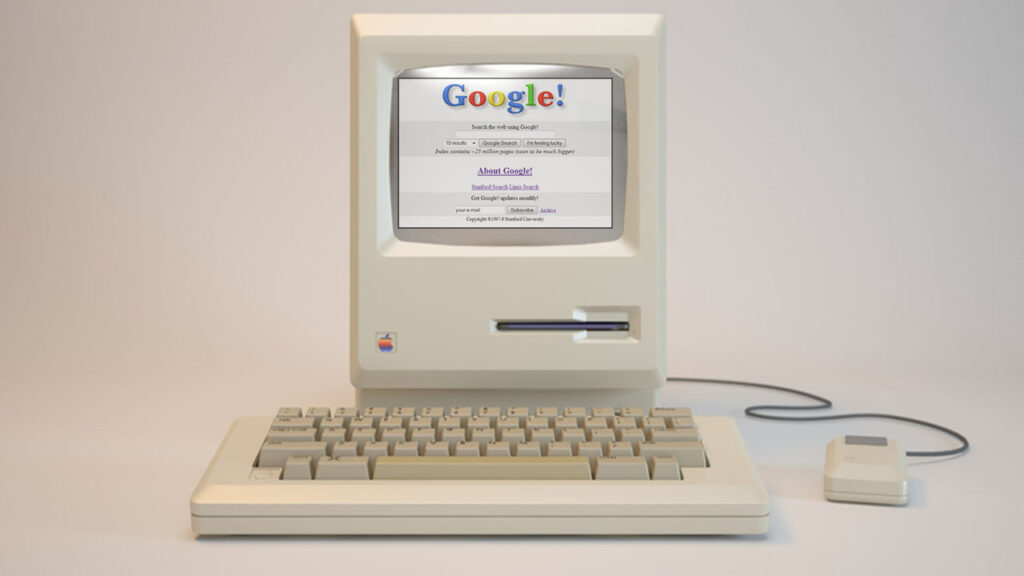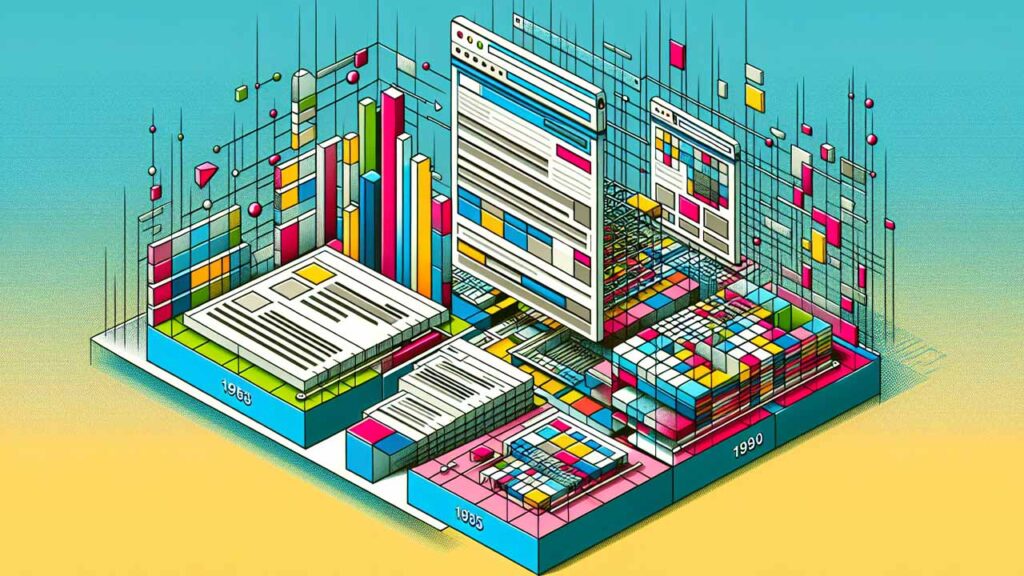Charting the Transformation: A Comprehensive Look at the Evolution of Web Design
Brett Lewis
Web Design - January 20, 2024

Curious about the journey from simple text pages to today’s interactive web experiences? This exploration into the evolution of web design traces key technological advancements and design innovations that have reshaped our online world. Witness how shifts from basic HTML to cutting-edge AI have influenced design, and anticipate what might come next in this ever-evolving field.
Key Takeaways
- Web design began with simplistic, text-based layouts ushered in by the creation of the first website by Tim Berners-Lee in 1989, using early versions of HTML that were geared towards the basic structure of content.
- The evolution of web design experienced significant milestones with the adoption of HTML tables for more complex designs, the era of interactive web design through Flash, and the clean separation of content from presentation via CSS.
- Responsive web design emerged as a crucial approach due to the growth of mobile internet usage, while content management systems like WordPress democratized web creation, and emerging technologies such as AI and VR are set to influence the future of web design.
Dawn of the Digital Canvas: The First Web Pages

Web design originated with the construction of the first website, a milestone accomplished by Tim Berners-Lee in 1989 at a Swiss research center. This website, created 30 years ago, was a basic, text-based page. The primary focus of these initial websites was on information dissemination, featuring text-based content with limited use of images and devoid of intricate design.
The first website set a simple visual framework for early web browsing, with its sans-serif font, uncomplicated white background, and blue hyperlinks. The straightforward nature of these initial websites, developed by the World Wide Web Consortium, set the stage for the evolution of web design, laying the groundwork for future web designers.
However, these first web pages were not without their limitations. The early versions of HTML, the hypertext markup language used to create websites, primarily facilitated the basic structure of content such as headings, paragraphs, and links. The accessibility of these pages was limited in the early 90s, but that was soon to change.
The arrival of HTML signaled a crucial turning point in the history of web design. As HTML evolved, it led to improvements in the structure and presentation of web content. This evolution was greatly influenced by the work of Tim Berners-Lee, who not only created the first website but also developed the first web browser on the World Wide Web, thereby laying the foundation for the revolutionary digital environment that followed.
From these humble origins, web design underwent continuous evolution, as designers started experimenting with intricate layouts and design elements. However, it was the introduction of HTML tables that truly marked the transition from simplicity to complexity in web design.
From Simplicity to Complexity: The Rise of HTML Tables

The introduction of HTML tables represented a key turning point in the history of web design. These tables facilitated the creation of more intricate layouts and multi-column designs, paving the way for more visually appealing websites. HTML tables catered to the growing demand for visually sophisticated websites and laid the foundation for responsive design.
As HTML evolved, particularly with the adoption of HTML 3.2, tables were officially included in the markup language specification. This led to their extensive utilization in web design, and they quickly became a crucial tool for web designers.
The use of HTML tables allowed web designers to create complex designs that were previously unattainable. In essence, tables were a stepping stone towards the creation of a more engaging and visually appealing web experience.
However, as the Internet continued to evolve, so too did the technologies used to create web pages. It was at this juncture that Adobe Flash entered the scene, revolutionizing web design once again.
The Flash Era: Adobe Flash and Interactive Web Design
Flash’s emergence in the late 1990s dramatically transformed the web design arena. Flash introduced animations and audio, significantly contributing to the improvement of web pages through movement and interactive elements. Flash enabled website owners to incorporate high-quality images, interactivity, and audio. It facilitated the development of intricate and interactive websites with animated elements, providing capabilities that surpassed those achievable with HTML. It’s worth noting that Macromedia Flash was the original name of this technology.
However, Flash was not without its challenges. It faced criticism from Steve Jobs due to:
- Poor security
- High energy consumption
- Lack of touch support
- Being perceived as a closed system
In 2020, Adobe, who had acquired Macromedia, discontinued support for Flash in favor of HTML5 and other technologies, citing compatibility issues and the heavy processing required for animations, leading to slower page loads.
The acquisition of Macromedia by Adobe had a substantial impact on the field of web design. It introduced software such as Flash to Adobe’s product lineup, significantly influencing the interactive features, animations, and audio functionalities in web design while also indirectly affecting search engine indexing.
As the limitations of Flash became apparent, a new technology emerged that would once again revolutionize the world of web design: Cascading Style Sheets, better known as CSS.
Cascading Style Sheets Revolution: The Birth of CSS

CSS instigated a substantial change in web design. This technology provided site owners with greater control over their website’s visual presentation, enabling adjustments in layouts, colors, and fonts. The result was cleaner layouts, simplified maintenance, and reduced file sizes, ultimately separating content from design and making the job of web designers more efficient.
The first proposal of ‘Cascading HTML Style Sheets’ was put forward by Håkon Wium Lie, and Bert Bos made significant contributions to the development of the CSS1 specification. This development happened around the same time as the first search engine, which was also a milestone in the evolution of the internet.
CSS1 served as the initial official language specification for HTML, XHTML, and XML documents. It led to improvements in the structure and presentation of web content, greatly impacting the design of early sites.
CSS techniques, such as CSS Sprites, have effectively enhanced web performance by decreasing HTTP requests. Additionally, CSS galleries like CSS Zen Garden and CSS Awards have showcased the diverse creative potentials of CSS in visual web design. These improvements have also contributed to better search engine optimization (SEO) practices.
CSS fundamentally altered the web design industry by offering a robust tool that simplified the creation of websites with complex layouts and designs for web designers. However, the advent of JavaScript and DHTML would soon bring another shift in web design.
The Dynamic Shift: JavaScript and DHTML

JavaScript, the first programming language that could add motion to static websites via interactive effects, drastically changed the web design landscape. It was conceptualized by Brendan Eich and was initially implemented as JScript 1.0 in Internet Explorer 3.0.
DHTML, a fusion of HTML, CSS, and JavaScript technology, improved interactivity and website dynamics by enabling real-time content changes without the need to reload the entire page. This feature has been crucial for enhancing user experience and search engine indexing.
JavaScript libraries like jQuery simplified the connections between JavaScript and HTML, thereby facilitating the development of dynamic and feature-rich websites for developers.
In 1998, JavaScript was standardized by ISO, marking a significant milestone in ensuring consistent language implementation across various web browsers and platforms. This was crucial for its widespread adoption in web design.
As mobile device usage began to surpass desktop usage, a new design approach was required to cater to the varying screen sizes of these devices. This led to the emergence of responsive web design.
Adapting to Users: The Onset of Responsive Web Design

Responsive web design is a method used to style HTML documents in order to adjust the display of website content to fit different resolutions or display sizes. An early example of such an implementation, although not aligning with the classic understanding of responsive web design as we know it today, was seen in Audi.com.
The introduction of the initial iPhone, marking the first inclusion of a web browser in a smartphone model, had a transformative effect on web design. This resulted in a substantial rise in mobile device web page views, currently at 57%, prompting the need for designs that accommodate diverse screen dimensions.
Opera Mini, a mobile web browser, improved the mobile browsing experience by employing Small-Screen Rendering technology. This technology preprocesses requested pages on Opera’s servers before presenting them to the user, making web pages more mobile-friendly.
Media Queries are a crucial element in responsive web design, as they enable web developers to modify the display of web page content based on factors such as:
- screen resolution
- device type
- orientation
- viewport size
This is fundamental for implementing a responsive web design approach.
Just as the dawn of the mobile era brought about the necessity for responsive web design, the rise of content management systems like WordPress made it easier for non-developers to create and manage websites, thereby democratizing web design.
Content Management Evolution: WordPress and Beyond
WordPress, developed by Matt Mullenweg and Mike Little, drastically changed how websites are created and managed. As an open-source content management system, it became the most popular CMS by 2003, with over 30% of websites worldwide utilizing this platform. The popularity of WordPress showcases its significant impact on web design and accessibility for non-developers. Whether for personal blogs or business websites, WordPress has made it easy for anyone to create a website, regardless of their technical skills.
At L4 Group, we have become specialists and experts at building HVAC websites, websites for heating oil companies, propane delivery websites, and plumber websites. We utilize WordPress as our preferred platform and develop custom-designed sites that are SEO-optimized and designed for maximum conversion.
Online code editors such as CodePen.io have also played a significant role in the evolution of web design. They serve as a browser-based platform for developers and designers to modify front-end languages and observe real-time outcomes. These platforms offer a range of resources, including frameworks, libraries, and UI patterns. They enable the creation and sharing of code snippets, referred to as ‘pens,’ among users, further simplifying the web development process.
As we move forward, the aesthetic of web design continues to evolve. In the 2010s, flat design and minimalism became popular, emphasizing user experience and efficient navigation while maintaining a visually appealing aesthetic.
The Modern Aesthetic: Flat Design and Minimalism
Flat design, a visual style known for its simple, two-dimensional elements, bright colors, and a clean, minimalist appearance, became popular in the 2010s. It typically includes clean lines, sans-serif typography, and prioritizes a straightforward, efficient user experience.
In contrast to rich design, which incorporates shadows, depth, color gradients, textures, and occasionally flashy animated gifs, flat design is defined by its clean, minimalistic approach featuring bright colors, 2D icons, and sans-serif typography. It avoids embellishments in order to facilitate more efficient navigation.
Design frameworks that implement flat design, such as Bootstrap 3, enable the creation of a contemporary and user-friendly interface.
Flat design and minimalism have shaped how web designers work, placing user interface and visual aesthetics at the forefront of web design. As a web designer, it’s essential to stay updated with these trends to create visually appealing and user-friendly websites.
As we look to the future, advancements in AI, VR, and other emerging technologies continue to shape the evolution of web design.
Looking Ahead: AI, VR, and the Future of Web Design
Emerging technologies such as artificial intelligence and virtual reality may shape the future of web design. The application of these technologies will be guided by design thinking, which prioritizes user needs, to ensure that user experience remains the focal point of web design advancements.
One of the key focuses in the future of web design will be accessibility. Standards such as WCAG 2.0 are establishing principles and classification levels (A, AA, AAA) for inclusive design that serves users with disabilities.
Keeping pace with advancements like AI is crucial as they can revolutionize web design with advanced navigation and experiences personalized to user data.
Ethical considerations are also crucial due to increasing privacy concerns and regulations such as the General Data Protection Regulation. User experience is of utmost importance, with aspects like micro-interactions and responsive javascript libraries like React playing a significant role in engaging users while upholding ethical design principles.
Summary
In sum, from the creation of the first web pages to the rise of responsive design, the world of web design has seen tremendous growth and innovation. It’s a field that continues to evolve, shaped by technology, user needs, and artistic creativity. Looking ahead, we can anticipate an exciting future of web design, with developments such as AI and VR continuing to push the boundaries of what’s possible. No matter where the journey takes us, one thing is certain: web design will remain an essential aspect of our digital lives, a testament to human ingenuity and creativity.
Frequently Asked Questions
How has web design evolved over the years?
Web design has evolved significantly over the years, transitioning from text-based sites with minimal images to advanced CSS designs and interactivity. This progression has led to more visually appealing and user-friendly websites.
What are the generations of web design?
The generations of web design are classified as Web 1.0, Web 2.0, Web 3.0, and Web 4.0, each with its own specific characteristics and features. Understanding these distinctions can help in identifying the evolution of web design practices.
Who created the first website?
The first website was created by Tim Berners-Lee in 1989.
What is Adobe Flash and how did it impact web design?
Adobe Flash was a technology that enhanced web design by allowing animations, audio, and interactivity in web pages, significantly impacting the improvement of web design.
What is CSS and how did it revolutionize web design?
CSS revolutionized web design by providing greater control over a website’s visual presentation, resulting in cleaner layouts, simplified maintenance, and reduced file sizes.
